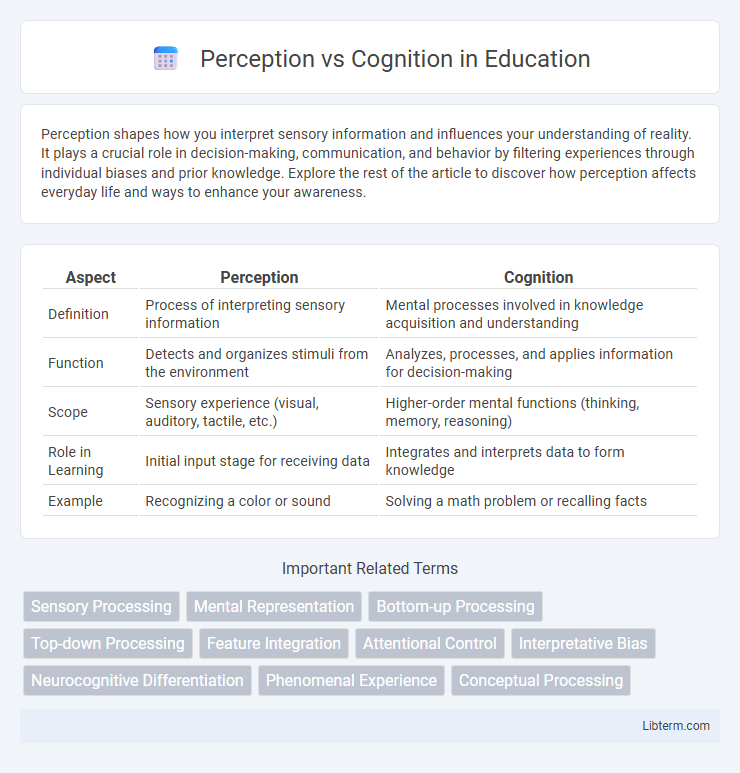Perception shapes how you interpret sensory information and influences your understanding of reality. It plays a crucial role in decision-making, communication, and behavior by filtering experiences through individual biases and prior knowledge. Explore the rest of the article to discover how perception affects everyday life and ways to enhance your awareness.
Table of Comparison
| Aspect | Perception | Cognition |
|---|---|---|
| Definition | Process of interpreting sensory information | Mental processes involved in knowledge acquisition and understanding |
| Function | Detects and organizes stimuli from the environment | Analyzes, processes, and applies information for decision-making |
| Scope | Sensory experience (visual, auditory, tactile, etc.) | Higher-order mental functions (thinking, memory, reasoning) |
| Role in Learning | Initial input stage for receiving data | Integrates and interprets data to form knowledge |
| Example | Recognizing a color or sound | Solving a math problem or recalling facts |
Understanding Perception and Cognition
Perception involves the sensory processing of environmental stimuli, enabling organisms to detect and interpret external inputs such as light, sound, and touch. Cognition encompasses higher-order mental processes including memory, reasoning, and decision-making, which allow for the organization and utilization of perceived information. Understanding perception and cognition reveals their interdependence, where accurate sensory data is crucial for effective cognitive functions and adaptive behavior.
Key Differences Between Perception and Cognition
Perception involves the process of detecting and interpreting sensory information from the environment through visual, auditory, tactile, olfactory, and gustatory inputs. Cognition refers to higher-level mental processes such as thinking, reasoning, memory, decision-making, and problem-solving that manipulate and analyze perceived information. The key difference lies in perception's role as the initial data acquisition stage, while cognition encompasses internal mental operations that give meaning and context to that sensory data.
The Process of Perception: How We Interpret Sensory Information
The process of perception involves the brain organizing sensory input from the environment into meaningful patterns through selective attention, pattern recognition, and interpretation based on prior knowledge. Sensory receptors in the eyes, ears, skin, and other organs detect stimuli, which are then transmitted via neural pathways to specific brain regions like the occipital and temporal lobes for processing. This interpretation enables individuals to understand objects, sounds, and spatial relationships, forming the foundation for cognition and subsequent decision-making.
The Role of Cognition in Information Processing
Cognition plays a critical role in information processing by structuring raw sensory input into meaningful data through processes such as attention, memory, and reasoning. It enables the interpretation of perceptual signals, allowing individuals to recognize patterns, make decisions, and solve problems effectively. The integration of cognitive functions transforms basic perception into complex understanding, essential for adaptive behavior and learning.
Interactions Between Perception and Cognition
Perception and cognition interact continuously, where perception provides sensory input that cognition interprets and organizes into meaningful concepts. Cognitive processes such as attention, memory, and expectation influence perceptual experiences by filtering and shaping sensory data. This bidirectional relationship enables humans to efficiently process complex environments, facilitating adaptive behavior and decision-making.
Neurobiological Foundations of Perception and Cognition
Perception and cognition rely on distinct yet interconnected neurobiological mechanisms, where perception is primarily mediated by sensory cortices that process external stimuli, and cognition involves higher-order brain regions like the prefrontal cortex responsible for decision-making, memory, and reasoning. Neural pathways in the thalamus play a crucial role in transmitting sensory information to cortical areas, while the hippocampus and association areas integrate this data for cognitive functions. Understanding the synaptic plasticity and neurotransmitter systems, such as glutamatergic and dopaminergic signaling, further elucidates how perception transitions into complex cognitive processes.
Perception, Cognition, and Subjective Reality
Perception involves the sensory processes through which individuals interpret external stimuli, forming the initial basis of experience. Cognition builds upon perception by enabling higher-order functions such as reasoning, memory, and decision-making, shaping how information is understood and utilized. Subjective reality emerges from the interplay between perception and cognition, where personal interpretations and mental constructs influence one's unique experience of the world.
Common Misconceptions About Perception and Cognition
Perception and cognition are often mistakenly thought to be the same, but perception involves the sensory process of recognizing stimuli, while cognition refers to interpreting and understanding that information. A common misconception is that perception is purely passive; in reality, it is an active process shaped by attention, expectations, and prior knowledge. Another error is assuming cognition occurs only after perception, though these processes frequently interact dynamically and simultaneously during information processing.
Applications in Psychology and Everyday Life
Perception involves the sensory process of acquiring and interpreting environmental stimuli, while cognition refers to higher-order mental functions such as thinking, memory, and decision-making. In psychology, understanding the interplay between perception and cognition aids in diagnosing and treating disorders like schizophrenia, where perceptual distortions affect cognitive processes. Everyday life applications include improving user experience design by leveraging perceptual cues and cognitive load management to enhance learning and decision-making efficiency.
Future Directions in Perception and Cognition Research
Emerging research in perception and cognition emphasizes integrating multisensory data with advanced neural network models to enhance understanding of human information processing. Future directions involve leveraging artificial intelligence and neuroimaging techniques to decode complex brain dynamics underlying perception-cognition interactions. Emphasis on personalized cognitive training and adaptive perceptual systems aims to revolutionize applications in education, healthcare, and human-computer interaction.
Perception Infographic

 libterm.com
libterm.com